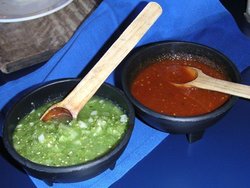Salsa (sauce)
|
|
- This article is about sauces; for other uses of Salsa see Salsa.
In Spanish, salsa can refer to any type of sauce, but in English it usually refers to the spicy, often tomato-based sauces typical of Latin American cuisine, particularly uncooked sauces or dips.
Salsa is the Spanish word for sauce, from Latin salsa of the same meaning, from sal, "salt"; "saline" and "salad" are related words. It is usually pronounced IPA in English; in Spanish it is pronounced .
Well-known salsas:
- Salsa roja, "red sauce": used as a condiment in Mexican and southwestern U.S. cuisine, and usually made with tomatoes, chile peppers, onion, garlic, and fresh cilantro (coriander leaves).
- Salsa cruda ("raw sauce"), also known as pico de gallo ("rooster's beak") or salsa mexicana ("Mexican sauce"): made with raw tomatoes, lime juice, chile peppers, onions, and other coarsely chopped raw ingredients.
- Salsa verde, "green sauce": made with tomatillos. Sauces made with tomatillos are usually cooked.
- Salsa brava, "wild sauce": usually made of a mayonnaise-Tabasco mix. On top of potato wedges, it makes the dish patatas bravas, typical of tapas bars in Catalonia.
- Guacamole: usually any sauce where the main ingredient is avocado.
- Mole (pronounced MOE-lay ): a Mexican sauce made from chile peppers mixed with spices, unsweetened chocolate, peanuts, and other ingredients.
There are many other salsas, both traditional and nouveau: for instance, some are made with mint, pineapple, or mango.
Health issues
Care should be taken in the preparation and storage of salsa due to the fact that many raw-served varieties can serve as a good growth medium for potentially dangerous bacteria, especially when unrefrigerated. In 2002 a study appearing in the journal Annals of Internal Medicine, conducted by the University of Texas-Houston Medical School, found that 66% of the sauces tested (71 samples tested, sauces being either: salsa, guacamole, or pico de gallo) from restaurants in Guadalajara, Jalisco, and 40% of those from Houston, Texas, were contaminated with E. coli bacteria. The researchers found that the Mexican sauces from Guadalajara more frequently contained fecal contaminants and higher levels of the bacteria than those of the sauces from Houston, possibly as a result of more common improper refrigeration of the Mexican sauces.
External links
- U.S. National Center for Home Food Preservation – Salsas (http://www.uga.edu/nchfp/how/can_salsa.html)
See also
Template:Cookbookparde:Salsa (Sauce) nl:Salsa (saus) ja:サルサ (料理) pl:Salsa (potrawa) fi:Salsa

